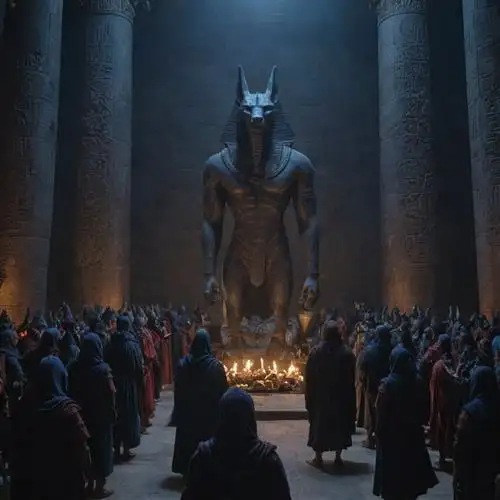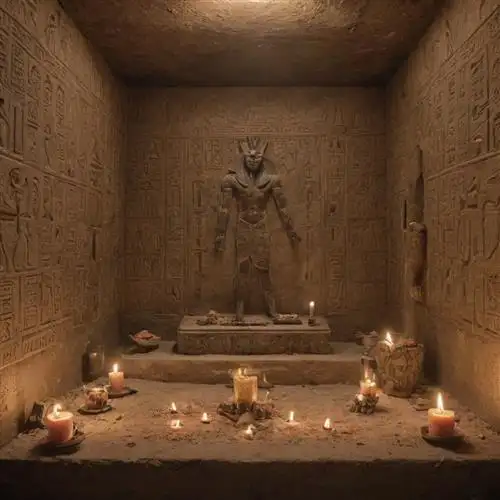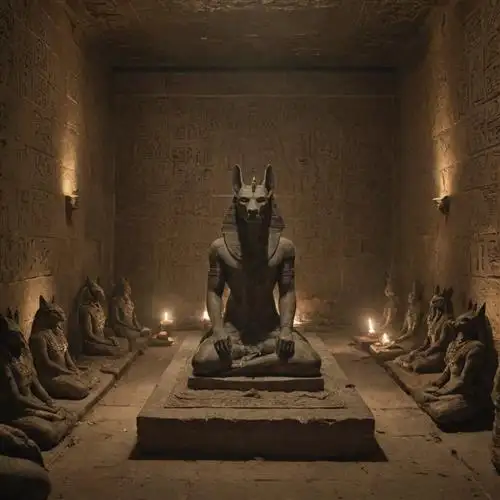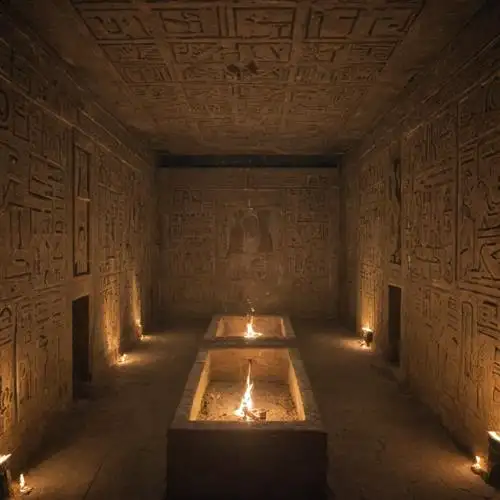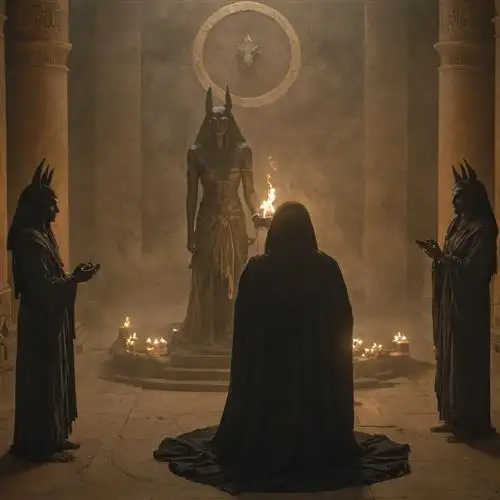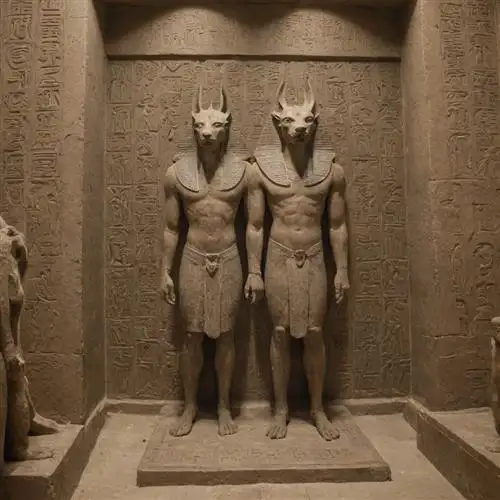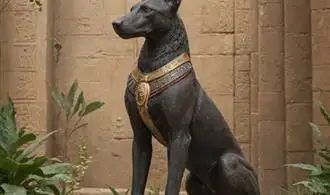
Anubis Invocation Ritual
The Anubis Invocation Ritual is a powerful practice that allows individuals to connect with the ancient Egyptian deity Anubis, the god of the dead, mummification, and the underworld. This ritual is believed to provide guidance, protection, and insight into the mysteries of the afterlife. Here are the key steps to perform this ritual:
Firstly, it's essential to create a sacred space for the ritual. This can be done by cleansing the area with sage, palo santo, or another purifying agent. Light candles, incense, or essential oils that resonate with Anubis, such as frankincense or myrrh. Set up an altar or shrine dedicated to Anubis, incorporating symbols and imagery associated with the deity, such as a black candle, a jackal statue or figurine, or the Ankh symbol.
Before invoking Anubis, take time to meditate, ground, and center yourself. Visualize the energy of Anubis surrounding you, and feel the connection to the underworld and the cycle of life and death. As you enter a state of deep focus, begin to call upon Anubis through a recitation or chant. You can use the following invocation or create your own:
"Anubis, Lord of the Underworld, Guide of Souls, I call upon you. Grant me your wisdom, your protection, and your sacred insight. Allow me to walk the path between life and death, that I may better understand the mysteries of existence. I am yours to command, Anubis, and I humbly seek your guidance."
As you recite the invocation, be open to any messages, visions, or sensations that may arise. Anubis may communicate through intuitive hits, symbolic imagery, or a sense of presence. Pay attention to any physical sensations, such as a shift in temperature, the feeling of a cool breeze, or the presence of a subtle energy shift.
After the invocation, take time to journal your experience, noting any insights, messages, or revelations you received. Consider how you can incorporate the wisdom of Anubis into your daily life and personal growth. Remember to express gratitude to the deity before concluding the ritual.
Anointing with Anubis Oil
The ritual of anointing with Anubis oil is a powerful practice that connects the devotee to the ancient Egyptian god of the dead and the afterlife. Anubis, the jackal-headed deity, is revered for his role in guiding the souls of the deceased through the underworld. By incorporating Anubis oil into your spiritual practice, you can harness the transformative energy of this powerful deity and invite his blessings into your life.
To begin the anointing ritual, you will need to procure high-quality Anubis oil, which can be found through reputable metaphysical suppliers or crafted using traditional recipes. This oil is typically infused with a blend of essential oils, herbs, and resins that are associated with Anubis, such as myrrh, frankincense, and cypress.
Before applying the oil, take a moment to center yourself and connect with the energy of Anubis. You may wish to light a candle, burn some incense, or recite a prayer or invocation to the deity. When you feel ready, gently apply the oil to your third eye, temples, and the pulse points on your wrists and neck. As you do so, visualize the energy of Anubis flowing into your body and enveloping you in his protective and transformative power.
The act of anointing with Anubis oil can be a deeply personal and meaningful experience. Some practitioners choose to use the ritual as a way to honor the dead, seeking Anubis's guidance and assistance in navigating the transition between life and death. Others may use the anointing as a means of personal transformation, calling upon Anubis to help them shed old patterns and embrace new beginnings.
Anubis Death Meditation
Anubis, the enigmatic jackal-headed deity, has long been revered in ancient Egyptian spirituality as the guardian of the dead and the one who guides the souls of the departed. Engaging in Anubis-focused death meditations can unlock profound insights into the nature of mortality, the afterlife, and the transformative power of the death experience. This practice invites you to confront your own mortality, embrace the mysteries of the underworld, and find solace in the steady presence of the Jackal-Headed God.
At the heart of the Anubis death meditation lies the exploration of the embalming process and the journey of the soul through the underworld. By visualizing the mummification rites, you can gain a deeper understanding of the Egyptian perspective on death, where the physical body is prepared for the afterlife, and the spirit is guided by Anubis through the perilous realms of the netherworld. This meditation encourages you to confront your fears of death, embrace the transformative power of the transition, and emerge with a renewed sense of purpose and connection to the cosmic cycle of life and death.
The Anubis death meditation often begins with an invocation, calling upon the Jackal-Headed God to be present and guide you through the process. As you enter a deeply meditative state, you may visualize yourself lying on the embalming table, surrounded by the ancient rituals and the watchful gaze of Anubis. Imagine the careful unwrapping of the body, the preservation of the organs, and the anointing of the skin with sacred oils. Feel the weight of the heavy amulets placed upon your chest, symbolizing the protection and guidance of the deities.
As the meditation deepens, you may envision your spirit self-separating from the physical form, guided by Anubis through the gates of the underworld. Witness the weighing of the heart against the feather of truth, the judgement of the soul, and the potential for transformation or rebirth. Embrace the darkness, the silence, and the profound mysteries that lie within the realm of Anubis.
Throughout this journey, you may encounter various symbols, archetypes, and guides that hold significant meaning within the Egyptian pantheon. Pay attention to the sensations, intuitions, and insights that arise, for they may hold the key to unlocking a deeper understanding of your own mortality and the nature of the afterlife. Remember, the Anubis death meditation is not meant to be a morbid exercise, but rather a profound exploration of the cycles of life, death, and rebirth.
Anubis Labyrinth Ritual
The Anubis Labyrinth Ritual is a powerful and transformative practice that allows you to connect with the ancient Egyptian god of the dead and the afterlife. This ritual is rooted in the belief that the labyrinth is a sacred space, representing the journey of the soul through the underworld. By walking the labyrinth, you can invoke the guidance and protection of Anubis, the jackal-headed deity who presides over the transition from life to death.
To perform the Anubis Labyrinth Ritual, you will need a dedicated space where you can create a temporary labyrinth. This can be as simple as using masking tape or chalk to outline a spiral pathway on the floor, or as elaborate as setting up a permanent labyrinth in your backyard or a designated room. The important thing is that the space feels sacred and conducive to deep introspection and spiritual exploration.
Before beginning the ritual, take some time to prepare yourself mentally and emotionally. Spend a few minutes in quiet meditation, focusing on your breath and setting an intention for your journey. You may also want to burn incense or light candles to create a contemplative atmosphere. As you enter the labyrinth, be mindful of your steps and the sensations you experience. Pay attention to any images, symbols, or insights that arise, as they may be messages from Anubis himself.
As you make your way through the labyrinth, consider the following:
- Reflect on the themes of death, transformation, and rebirth that Anubis represents. What aspects of your life are in need of change or renewal?
- Visualize Anubis walking alongside you, offering guidance and protection. Imagine the jackal-headed deity illuminating the way and guarding your path.
- Pay attention to any obstacles or challenges you encounter along the way, and see them as opportunities for growth and self-discovery.
- When you reach the center of the labyrinth, take a moment to pause and connect with the energy of Anubis. Offer a prayer or meditation, and ask for his blessings and insights.
Anubis Necromantic Ritual
The Anubis Necromantic Ritual is a profound and transformative practice that connects the living with the realm of the dead. This ancient ritual, steeped in the mysticism of ancient Egypt, is a powerful tool for those seeking to commune with the departed, uncover hidden knowledge, and explore the mysteries of the afterlife. At its core, the Anubis Necromantic Ritual is a sacred rite that invokes the presence of Anubis, the jackal-headed god of the dead, to guide the practitioner through the dark and enigmatic realms of the underworld.
The ritual begins with a meticulous preparation of the sacred space, where the practitioner creates an altar adorned with symbols and offerings that honor the mighty Anubis. This may include candles, incense, and representations of the god himself, such as statues or paintings. The practitioner then enters a meditative state, focusing their mind and opening themselves to the energies of the ritual. Through chanting, visualization, and deep contemplation, they call upon Anubis to manifest and lend his wisdom and protection.
As the ritual unfolds, the practitioner may encounter visions, dreams, or even direct communication with the spirits of the departed. Anubis, the gatekeeper of the afterlife, is believed to guide the practitioner through the treacherous realms of the underworld, providing insights and knowledge that can be applied to the living world. This How to Navigate the Afterlife Without Fearing Anubis can be an invaluable resource for those seeking to overcome their fear of death and better understand the mysteries of the afterlife.
The Anubis Necromantic Ritual is not to be taken lightly, as it involves delving into the realms of the dead and the unknown. Practitioners must approach the ritual with reverence, respect, and a deep understanding of the risks and responsibilities involved. It is essential to prepare oneself both mentally and spiritually, and to seek guidance from experienced practitioners or spiritual leaders who can provide the necessary support and protection.
Anubis Embalming Ritual
The Anubis Embalming Ritual is a sacred and powerful practice that has been revered for centuries. This ritual, deeply rooted in ancient Egyptian mythology, is believed to hold the key to the journey of the soul after death. As the god of embalming and the protector of the dead, Anubis played a crucial role in the mummification process, guiding the deceased through the afterlife.
At the heart of the Anubis Embalming Ritual lies the belief that the preservation of the physical body is essential for the soul's transition to the next realm. The ritual involves a meticulous and intricate process, performed by skilled priests and embalmers, to ensure the proper preparation of the deceased for their eternal rest.
One of the most significant aspects of the Anubis Embalming Ritual is the purification of the body. This involves the removal of the internal organs, which were then placed in canopic jars, and the careful drying and preservation of the remaining tissues. The body was then wrapped in linen bandages, with sacred amulets and talismans placed within the wrappings to provide protection and guidance for the soul.
The ritual also includes the invocation of Anubis himself, as the officiating priests call upon the god to watch over the deceased during the embalming process and to ensure their safe passage to the afterlife. This invocation is believed to imbue the mummy with the divine power and protection of Anubis, offering the deceased a secure and profound transition to the next realm.
Moreover, the Anubis Embalming Ritual was not solely focused on the physical preparation of the body; it also involved a spiritual and emotional component. The ritual was a time of profound reflection, where the family and loved ones of the deceased could pay their respects and bid farewell to the departed soul. This aspect of the ritual was essential in providing comfort and closure to the grieving and honoring the life of the individual.

